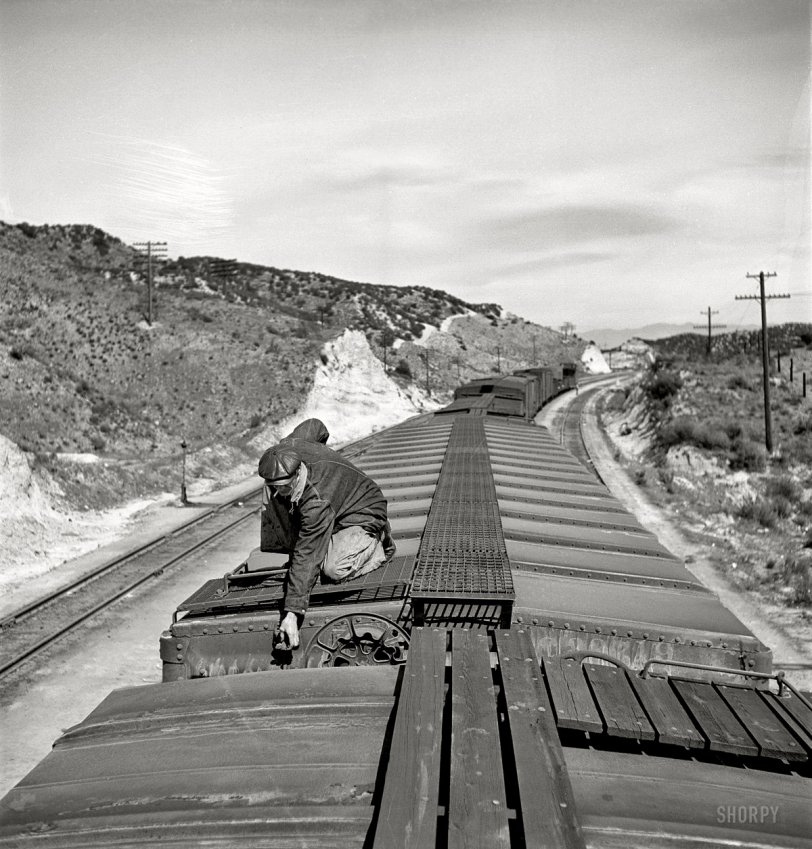


Framed or unframed, desk size to sofa size, printed by us in Arizona and Alabama since 2007. Explore now.
Shorpy is funded by you. Patreon contributors get an ad-free experience.
Learn more.

- Tough Guys
- Lost in Toyland
- And without gloves
- If I were a blindfolded time traveler
- Smoke Consumer Also Cooks
- Oh that stove!
- Possibly still there?
- What?!?
- $100 Reward
- Freeze Frame
- Texas Flyer wanted
- Just a Year Too Soon
- WWII -- Replacing men with women at the railroad crossing.
- Yes, Icing
- You kids drive me nuts!
- NOT An Easy Job
- I wonder
- Just add window boxes
- Icing Platform?
- Indiana Harbor Belt abides
- Freezing haze
- Corrections (for those who care)
- C&NW at Nelson
- Fallen Flags
- A dangerous job made worse
- Water Stop
- Passenger trains have right of way over freights?
- Coal
- Never ceases to amaze me.
- Still chuggin' (in model form)
Print Emporium
Downgrade: 1943

March 1943. Summit, California. "Brakeman opening the retainer valve on a car on the Atchison, Topeka and Santa Fe Railroad between Barstow and San Bernardino. From here to San Bernardino is one long downgrade of more than 2,700 feet." Photo by Jack Delano, Office of War Information. View full size.
Richard Feynman explains
"What keeps the train on the track?"
The squealing noise
Usually the squealing noise isn't the brakes -- it's the flanges rubbing up against the rails. The load-bearing part of the wheels is slightly cone-shaped, and generally it's arranged so that a train traveling at the usual speed sits centered between the rails, and the flanges don't touch anything. If it travels faster or slower, the wheels get pulled up against the rail, and you get that "sawing an armored knight in half" screech. A lot of places on particularly curvy bits (and mountain grades, as a rule, are pretty curvy) they'll have flange oilers which pump grease on the flanges when the wheels run over them.
I'm guessing, BTW, that the train is stopped at this point. I don't know whether the rules said that you couldn't climb on moving cars yet (I think not), but I have to wonder how Delano managed to get everything set up otherwise, not to mention how the brakeman is going to get past him without one of them falling off.
Superb photo
I love the way the train is framed by the white of the cut hillside and the dirt road up the hill, to the left, and the parallel tracks to the right. The brakeman is perfect; he gives scale to the image, and the cigarette gripped between his teeth is a nice touch.
I wonder who the fellow is standing up the tracks to the right.
Slower Brake Releases
Retainers are used on downhill grades where train speed builds more quickly than the ability of the air brake system to reset the brakes.
Each car's retainer valve slows brake release on that car. By slowing the rate of release, retainers give the engineer more time to fully recharge the train's brake system and avoiding "pissing away" the air.
Retainer valve
This might help those who are not familiar with a retainer valve and explain why those freight trains make that squealing sound on the downside of long grades.
The retainer is a way of "keeping" some of the brake application even after the brakes are released. When an AB brake releases cylinder pressure, it vents it out the "retainer" port. On most cars, this leads to a retaining valve located on the side of the car. The retaining valve retains pressure in the cylinder when the control valve tries to release it. It can be set for "direct", which lets the air out directly, or "retain 10 pounds" which keeps the last 10 pounds of pressure in the cylinder.
This is used to descend long grades: with the retainers turned up, the cars will hold ten pounds of brakes even while the brakes are fully released and recharging. More advanced retainers added two more settings: retain 20 pounds, and slow release, which would release fully but took about 90 seconds to do it.
Retaining Valve
The retaining valve keeps the brakes applied on the cars you choose.
That keeps you from having to apply and release brakes repeatedly going down the hill, which is a bad thing to do because each time you do it, you have less brakes.
Retainer Valve
What does a retainer valve do? Great photo. Jack Delano never disappoints.
Road to Sin City
The railway from Barstow to San Bernardino closely parallels US 15. Driving Los Angeles to Las Vegas takes you on this route.
























On Shorpy:
Today’s Top 5